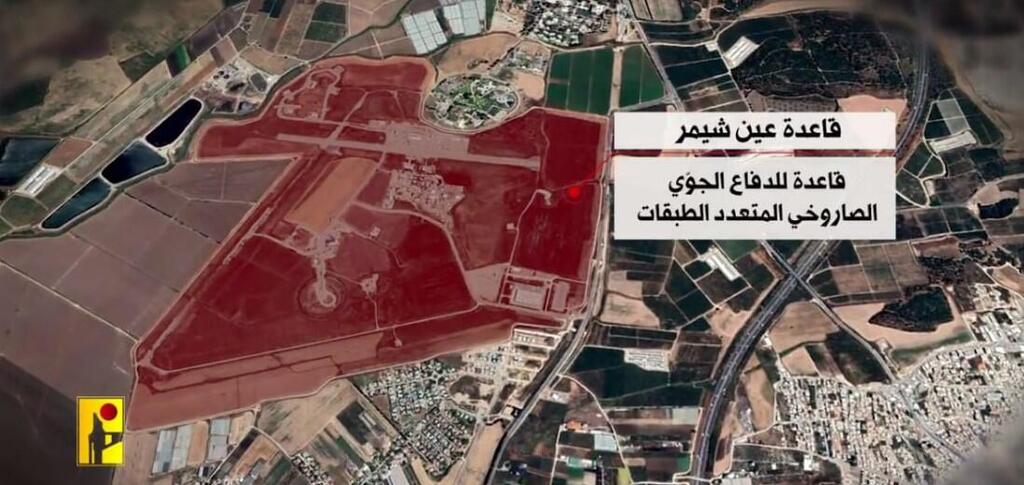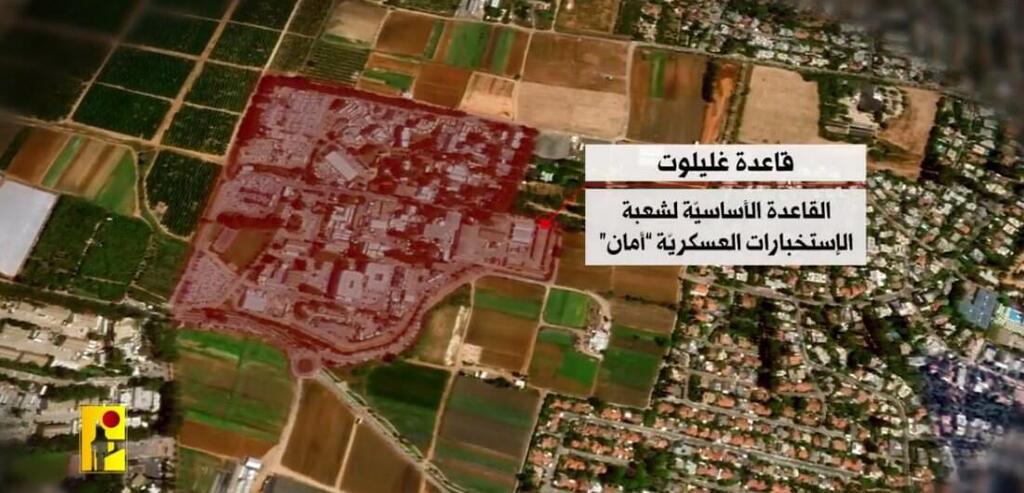Getting your Trinity Audio player ready...
In a twist reminiscent of a spy novel, Mossad’s secretive headquarters and a top-tier intelligence-gathering unit, coupled with a base allegedly masterminding GPS disruptions across the Middle Eastern skies--were thrust into the limelight by none other than Hezbollah’s Secretary-General, Hassan Nasrallah. He claimed these were the chosen targets of the terrorist organization’s morning assault, an attack largely thwarted by IDF's preemptive maneuvers.
A Hezbollah video highlighting the targets
In his address, Nasrallah named the Glilot area near Tel Aviv and the Ein Shemer base close to Hadera as prime targets for their UAV assault, with a barrage of hundreds of rockets intended to create a diversion for the UAVs. The goal, he asserted, was military retribution linked to the assassination of Fuad Shukr and an attack in Haifa—perilously close to Tel Aviv.
Nasrallah detailed, “Glilot, just about 68 miles from the Lebanon border and a mere mile from Tel Aviv, was our central target. This location is closely associated with Mossad, Military Intelligence, and Unit 8200. We also earmarked a secondary target, the Ein Shemer base for air defense and missile forces, 45 miles from Lebanon and 25 miles from Tel Aviv.”
In a video released by Hezbollah, the base’s location was pinpointed, with annotations highlighting that it hosts Arrow, David's Sling, and Iron Dome batteries, alongside the headquarters of the Menashe Brigade and a UAV testing airfield.
Ein Shemer Air Force Base, founded by the British Army near a kibbutz in 1943 and named after it, ceased to function as an airbase soon after the War of Independence, transitioning to an immigrant camp. Over two decades ago, following much contention, an Arrow missile battery found its home there. The airstrip in the vicinity serves as a launchpad for unmanned aerial vehicles from Israel Aerospace Industries.
Last month, the New York Times shed light on the University of Texas researchers’ identification of the Ein Shemer base as the epicenter of GPS disruptions plaguing the Middle East. Researchers indicated that these assaults, known as "spoofing," manipulate GPS signals, leading aircraft systems to misidentify their location. Consequently, planes often appeared on flight tracking sites as being over Beirut, when in reality, they were elsewhere entirely. Researchers expressed confidence that the source of these GPS disruptions, which also impact navigation-based services in Israel, stems from the Ein Shemer base. IDF refrained from commenting on the report.
In the early 2000s, a UAV school sprouted at the base, and by 2004, it was publicized in the Air Force magazine that UAV operators conducted practical studies there. A few years later, the school was relocated.
The Glilot Camps in Ramat Hasharon encompass the central base of Unit 8200—the signals intelligence arm of the National Intelligence Directorate—the Military Intelligence School, and military colleges. Nestled nearby is the once-clandestine Mossad headquarters.
The Hezbollah video asserted that “Glilot is the main base of Military Intelligence, incorporating the central hub of Unit 8200, which is responsible for SIGINT and cyber operations, alongside a military intelligence base and military colleges. It also comprises the communications battalion of the Military Intelligence Directorate.”
Shortly after the War of Independence, IDF began establishing bases in the area, with Unit S.M. 2—later renamed 8200—relocating to the base in 1952. Sixteen years ago, a decision was made to evacuate most of the Glilot compound as part of the IDF’s move to the Negev. After numerous delays, this transition is anticipated to occur over the coming years in several phases.
According to Hezbollah, the UAV launches targeting Glilot and Ein Shemer were merely a “first stage” response to the assassination of the terrorist organization’s Chief of Staff, Fuad Shukr. He met his end late last month in an Israeli strike in Dahiya, Beirut. The Wall Street Journal reported this operation succeeded due to a breach of the organization’s internal network, coupled with a phone call luring him to the seventh floor of the building where he resided and worked.
Nasrallah recounted that Shukr conversed with him just hours before his demise. On the eve of the assassination, a Hezbollah source told the newspaper, “Shukr received a call from someone instructing him to go up to his apartment—five floors up. Around 19:00, Israeli ordnance was deployed into the apartment and three floors below—resulting in the deaths of Shukr, his wife, two other women, and two children.” The Hezbollah source suggested the request for Shukr to ascend to the seventh floor, making him an easier target, came from “someone who likely breached Hezbollah's internal communication network.” This might explain Nasrallah’s choice of an intelligence base as a target.







